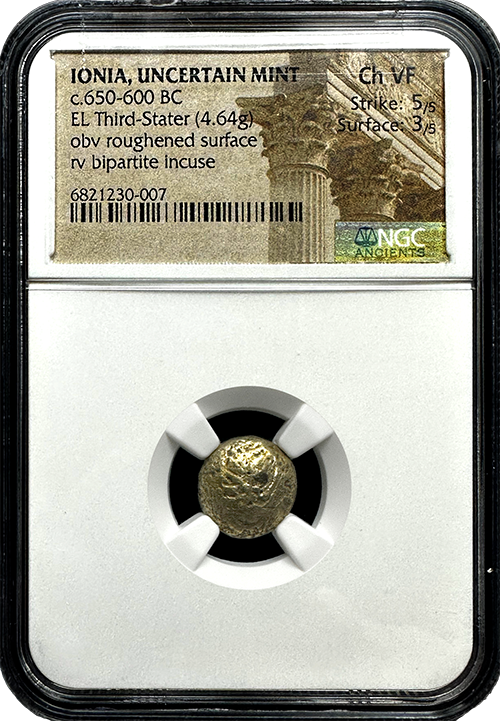The Birth of Coins: Ionia's Enduring Legacy
The dawn of ancient coinage heralded a monumental shift in the history of human civilization. Before coins, ancient societies navigated a complex web of barter systems in their trade and transactions. It was in the heart of this transformative era that Ionia emerged. The dawn of ancient coinage started in a coastal region in modern-day Turkey and emerged as a vibrant hub of commerce. Additionally, intellectual exchange pioneered a concept that would forever alter how the world conducted business.
The Challenge of Barter Systems
Before coins, the exchange of goods and services relied on barter systems. While effective in some cases, barter had its limitations. For instance, what if one wanted to trade a surplus of grain for tools or acquire services? These limitations spurred the need for a more efficient, standardized form of trade. This need was deeply felt in Ionia, a region at the crossroads of cultures and commerce.
Electrum: The Precursor to Coins
Enter electrum, a naturally occurring alloy of gold and silver found in the region. Electrum not only had intrinsic value but was also relatively easy to work with. Besides, it made an ideal candidate for the world's first standardized currency. By shaping electrum into standardized coins, merchants and traders no longer had to negotiate the value of goods and services. Electrum coins allowed for smoother transactions and facilitated trade over vast distances, giving rise to the birth of coinage.
The Advent of Coins: Ionia's Pioneering Role
The early Ionian city-states were crucibles of invention and innovation. Consequently, it fostered the birth of a remarkable concept – standardized currency in the form of coins. Ionia, located along the Aegean coast of Anatolia, was in the midst of a profound intellectual and commercial awakening. Particularly, during the 7th century BC.
Barter systems, while functional, had their limitations. There was a need for a more efficient means of exchange, one that could transcend the confines of mere barter. This is where the Ionian city-states come into the picture. They recognized that to unlock the full potential of their burgeoning trade networks, they needed a universal medium of exchange. Coins, forged from a naturally occurring alloy called electrum, emerged as the solution.
Understanding the Coins
While delving into the mystery of ancient coins, particularly electrum coins like the El Third-Stater, we encounter an intriguing feature. Specifically, the deliberately roughened surface of the coin's obverse. This roughness remains a subject of scholarly debate. Some speculate it might have been an early attempt at adding texture or security features. Meanwhile, others offered insights into the experimental nature of coinage at the time.
Bipartite Incuse: A Puzzling Symbol
On the reverse side of the coin, we discover a distinct feature – two bipartite incuse punches deeply impressed into the metal. These incuse punches are emblematic of early electrum coins in the Ionian region. The simplicity of these marks reflects the crude methods of the time. Therefore, leaving a square imprint just adds a layer of historical intrigue to this ancient coin.
 The Ionia, Uncertain Mint El Third-Stater
The Ionia, Uncertain Mint El Third-Stater
Dated to the period between 650-600 BC, the Ionia, Uncertain Mint El Third-Stater is a tangible link to the roots of modern monetary systems. Weighing 4.64 grams, this ancient coin offers a unique window into a time when currency was in its infancy. In a Choice Very Fine condition, with an impressive Strike rating of 5/5 and a Surface rating of 3/5, this coin stands as a priceless relic of the past.
A Numismatic Treasure
What sets the El Third-Stater apart is not just its individuality but also its remarkable condition considering its age. This ancient relic from the 7th century BC boasts a Strike rating of 5/5, indicating that its design remains remarkably sharp and well-defined. Despite its overall Surface condition being rated at 3/5, implying some wear consistent with centuries of circulation, the coin's integrity and historical significance remain deeply impressive.
Historical Significance
The Ionian region was celebrated for its contributions to philosophy, science, and commerce. Amidst profound questions of existence and a burgeoning network of ambitious merchants traversing extensive trade routes, the need for standardized currency began to crystalize. It marked a transformative moment in history, one that would echo through the ages.
Dawn of Ancient Coinage Conclusion
In Ionia, the dawn of ancient coinage occurred around 650-600 BC, a remarkable era that beckons us to delve further into the origins of currency. These coins from Ionian mints exhibit distinct features, including roughened obverse designs and the signature bipartite incuse punches on the reverse. While the exact meaning behind these ancient marks remains a historical enigma, their presence on these coins adds a layer of intrigue. These remarkable and impressive examples are highly coveted by numismatists and history enthusiasts. Undeniably, they offer a tangible link to the establishment of standardized currency in the ancient world.
